BSBWHS414: WHS Risk Management, Regulations & Workplace Safety Review
VerifiedAdded on 2023/06/05
|26
|7052
|392
Homework Assignment
AI Summary
This assignment solution for BSBWHS414 focuses on contributing to WHS risk management, detailing employer duties as per the Occupational Health and Safety Act 2004 (Vic), and exploring hazardous activities outlined in the Occupational Health and Safety Regulations 2017. It covers hazard identification, risk assessment, risk control, and review requirements, including reporting procedures and compliance with WHS risk management obligations. The solution identifies internal and external resources for workplace health and safety reviews, discusses the power of Health and Safety Representatives (HSRs), and explains how information and data are shared through various processes like health and safety committee meetings, employee training, workplace inspections, and WHSMS. The document also addresses risk assessment methods, actions HSRs can initiate, and provides examples of common workplace hazards and their causes. Desklib offers a wealth of similar solved assignments and past papers to aid students in their studies.
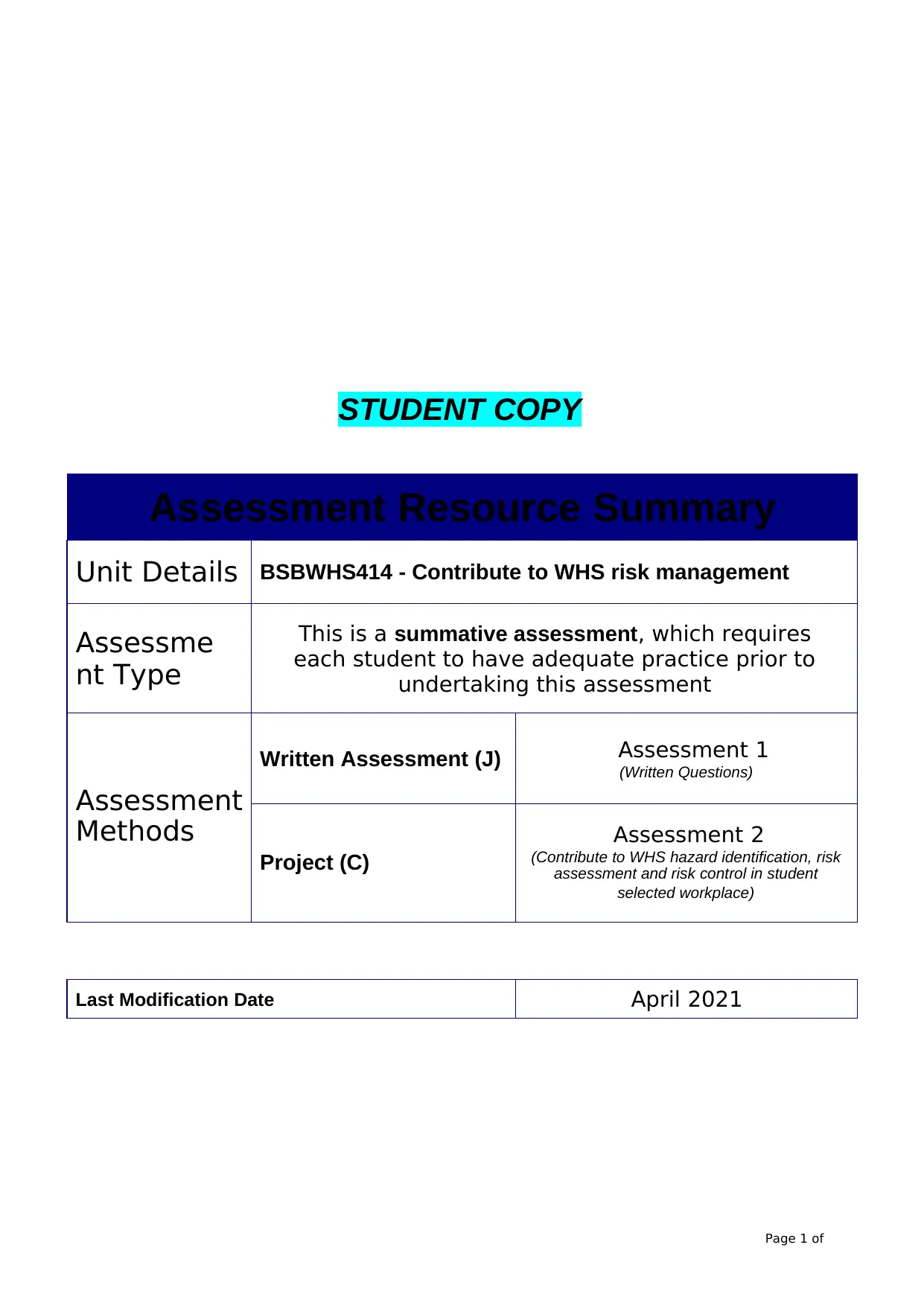
Page 1 of
16
STUDENT COPY
Assessment Resource Summary
Unit Details BSBWHS414 - Contribute to WHS risk management
Assessme
nt Type
This is a summative assessment, which requires
each student to have adequate practice prior to
undertaking this assessment
Written Assessment (J) Assessment 1
(Written Questions)
Assessment
Methods Assessment 2
Project (C) (Contribute to WHS hazard identification, risk
assessment and risk control in student
selected workplace)
Last Modification Date April 2021
16
STUDENT COPY
Assessment Resource Summary
Unit Details BSBWHS414 - Contribute to WHS risk management
Assessme
nt Type
This is a summative assessment, which requires
each student to have adequate practice prior to
undertaking this assessment
Written Assessment (J) Assessment 1
(Written Questions)
Assessment
Methods Assessment 2
Project (C) (Contribute to WHS hazard identification, risk
assessment and risk control in student
selected workplace)
Last Modification Date April 2021
Paraphrase This Document
Need a fresh take? Get an instant paraphrase of this document with our AI Paraphraser
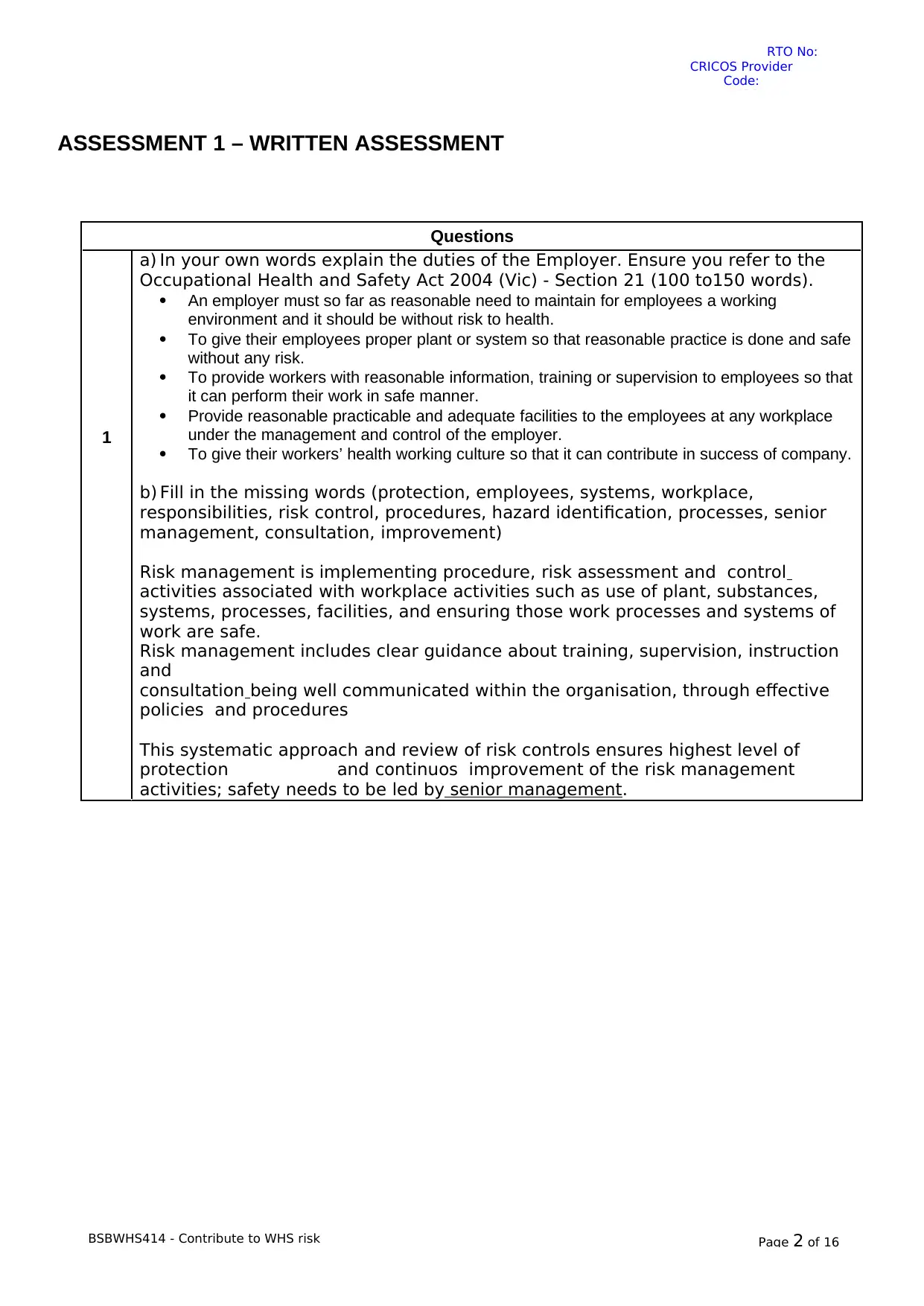
RTO No:
CRICOS Provider
Code:
ABN:
BSBWHS414 - Contribute to WHS risk
management Page 2 of 16
ASSESSMENT 1 – WRITTEN ASSESSMENT
Questions
1
a) In your own words explain the duties of the Employer. Ensure you refer to the
Occupational Health and Safety Act 2004 (Vic) - Section 21 (100 to150 words).
An employer must so far as reasonable need to maintain for employees a working
environment and it should be without risk to health.
To give their employees proper plant or system so that reasonable practice is done and safe
without any risk.
To provide workers with reasonable information, training or supervision to employees so that
it can perform their work in safe manner.
Provide reasonable practicable and adequate facilities to the employees at any workplace
under the management and control of the employer.
To give their workers’ health working culture so that it can contribute in success of company.
b) Fill in the missing words (protection, employees, systems, workplace,
responsibilities, risk control, procedures, hazard identification, processes, senior
management, consultation, improvement)
Risk management is implementing procedure, risk assessment and control
activities associated with workplace activities such as use of plant, substances,
systems, processes, facilities, and ensuring those work processes and systems of
work are safe.
Risk management includes clear guidance about training, supervision, instruction
and
consultation being well communicated within the organisation, through effective
policies and procedures
This systematic approach and review of risk controls ensures highest level of
protection and continuos improvement of the risk management
activities; safety needs to be led by senior management.
CRICOS Provider
Code:
ABN:
BSBWHS414 - Contribute to WHS risk
management Page 2 of 16
ASSESSMENT 1 – WRITTEN ASSESSMENT
Questions
1
a) In your own words explain the duties of the Employer. Ensure you refer to the
Occupational Health and Safety Act 2004 (Vic) - Section 21 (100 to150 words).
An employer must so far as reasonable need to maintain for employees a working
environment and it should be without risk to health.
To give their employees proper plant or system so that reasonable practice is done and safe
without any risk.
To provide workers with reasonable information, training or supervision to employees so that
it can perform their work in safe manner.
Provide reasonable practicable and adequate facilities to the employees at any workplace
under the management and control of the employer.
To give their workers’ health working culture so that it can contribute in success of company.
b) Fill in the missing words (protection, employees, systems, workplace,
responsibilities, risk control, procedures, hazard identification, processes, senior
management, consultation, improvement)
Risk management is implementing procedure, risk assessment and control
activities associated with workplace activities such as use of plant, substances,
systems, processes, facilities, and ensuring those work processes and systems of
work are safe.
Risk management includes clear guidance about training, supervision, instruction
and
consultation being well communicated within the organisation, through effective
policies and procedures
This systematic approach and review of risk controls ensures highest level of
protection and continuos improvement of the risk management
activities; safety needs to be led by senior management.
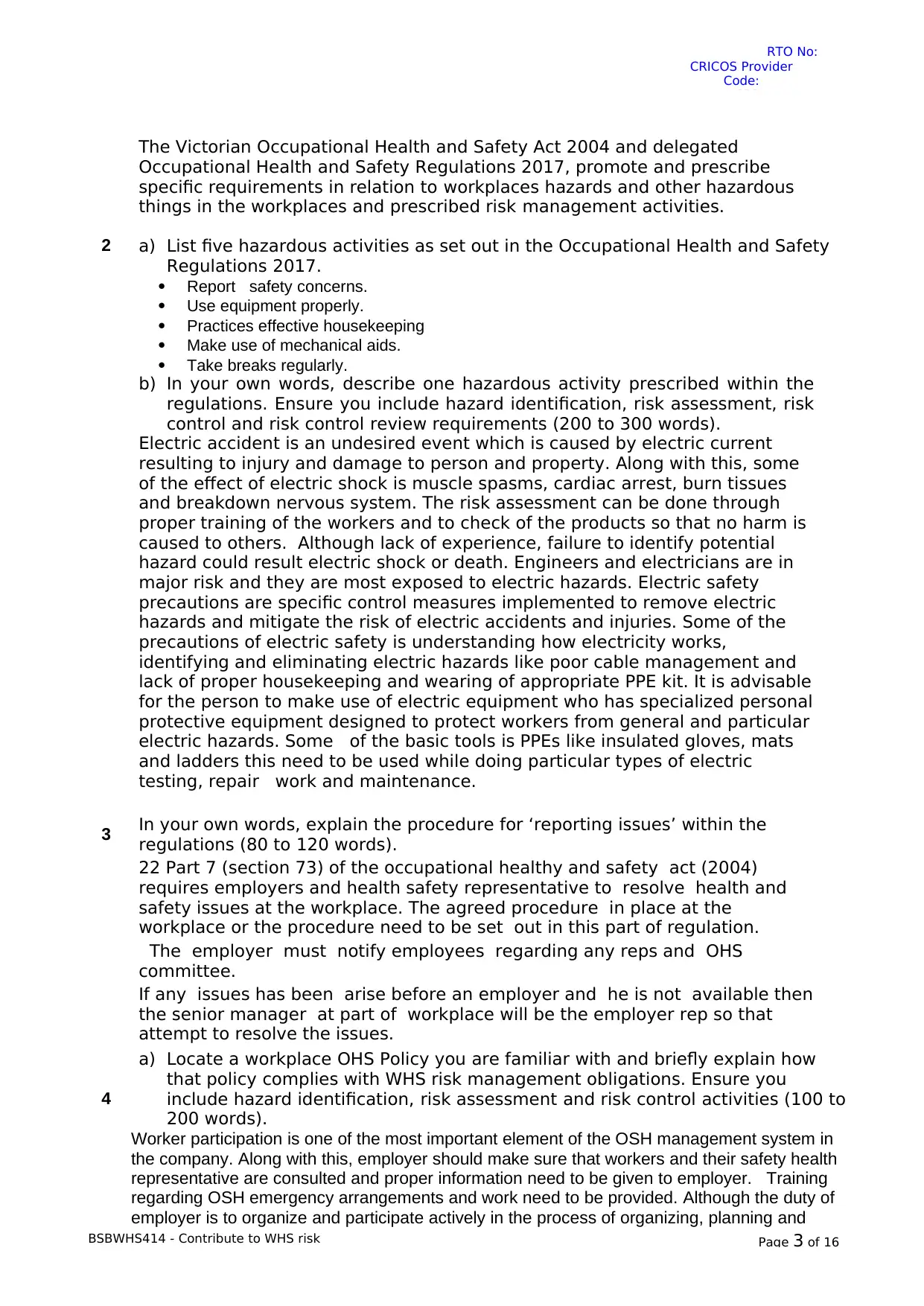
RTO No:
CRICOS Provider
Code:
ABN:
BSBWHS414 - Contribute to WHS risk
management Page 3 of 16
2
The Victorian Occupational Health and Safety Act 2004 and delegated
Occupational Health and Safety Regulations 2017, promote and prescribe
specific requirements in relation to workplaces hazards and other hazardous
things in the workplaces and prescribed risk management activities.
a) List five hazardous activities as set out in the Occupational Health and Safety
Regulations 2017.
Report safety concerns.
Use equipment properly.
Practices effective housekeeping
Make use of mechanical aids.
Take breaks regularly.
b) In your own words, describe one hazardous activity prescribed within the
regulations. Ensure you include hazard identification, risk assessment, risk
control and risk control review requirements (200 to 300 words).
Electric accident is an undesired event which is caused by electric current
resulting to injury and damage to person and property. Along with this, some
of the effect of electric shock is muscle spasms, cardiac arrest, burn tissues
and breakdown nervous system. The risk assessment can be done through
proper training of the workers and to check of the products so that no harm is
caused to others. Although lack of experience, failure to identify potential
hazard could result electric shock or death. Engineers and electricians are in
major risk and they are most exposed to electric hazards. Electric safety
precautions are specific control measures implemented to remove electric
hazards and mitigate the risk of electric accidents and injuries. Some of the
precautions of electric safety is understanding how electricity works,
identifying and eliminating electric hazards like poor cable management and
lack of proper housekeeping and wearing of appropriate PPE kit. It is advisable
for the person to make use of electric equipment who has specialized personal
protective equipment designed to protect workers from general and particular
electric hazards. Some of the basic tools is PPEs like insulated gloves, mats
and ladders this need to be used while doing particular types of electric
testing, repair work and maintenance.
3 In your own words, explain the procedure for ‘reporting issues’ within the
regulations (80 to 120 words).
22 Part 7 (section 73) of the occupational healthy and safety act (2004)
requires employers and health safety representative to resolve health and
safety issues at the workplace. The agreed procedure in place at the
workplace or the procedure need to be set out in this part of regulation.
The employer must notify employees regarding any reps and OHS
committee.
If any issues has been arise before an employer and he is not available then
the senior manager at part of workplace will be the employer rep so that
attempt to resolve the issues.
4
a) Locate a workplace OHS Policy you are familiar with and briefly explain how
that policy complies with WHS risk management obligations. Ensure you
include hazard identification, risk assessment and risk control activities (100 to
200 words).
Worker participation is one of the most important element of the OSH management system in
the company. Along with this, employer should make sure that workers and their safety health
representative are consulted and proper information need to be given to employer. Training
regarding OSH emergency arrangements and work need to be provided. Although the duty of
employer is to organize and participate actively in the process of organizing, planning and
CRICOS Provider
Code:
ABN:
BSBWHS414 - Contribute to WHS risk
management Page 3 of 16
2
The Victorian Occupational Health and Safety Act 2004 and delegated
Occupational Health and Safety Regulations 2017, promote and prescribe
specific requirements in relation to workplaces hazards and other hazardous
things in the workplaces and prescribed risk management activities.
a) List five hazardous activities as set out in the Occupational Health and Safety
Regulations 2017.
Report safety concerns.
Use equipment properly.
Practices effective housekeeping
Make use of mechanical aids.
Take breaks regularly.
b) In your own words, describe one hazardous activity prescribed within the
regulations. Ensure you include hazard identification, risk assessment, risk
control and risk control review requirements (200 to 300 words).
Electric accident is an undesired event which is caused by electric current
resulting to injury and damage to person and property. Along with this, some
of the effect of electric shock is muscle spasms, cardiac arrest, burn tissues
and breakdown nervous system. The risk assessment can be done through
proper training of the workers and to check of the products so that no harm is
caused to others. Although lack of experience, failure to identify potential
hazard could result electric shock or death. Engineers and electricians are in
major risk and they are most exposed to electric hazards. Electric safety
precautions are specific control measures implemented to remove electric
hazards and mitigate the risk of electric accidents and injuries. Some of the
precautions of electric safety is understanding how electricity works,
identifying and eliminating electric hazards like poor cable management and
lack of proper housekeeping and wearing of appropriate PPE kit. It is advisable
for the person to make use of electric equipment who has specialized personal
protective equipment designed to protect workers from general and particular
electric hazards. Some of the basic tools is PPEs like insulated gloves, mats
and ladders this need to be used while doing particular types of electric
testing, repair work and maintenance.
3 In your own words, explain the procedure for ‘reporting issues’ within the
regulations (80 to 120 words).
22 Part 7 (section 73) of the occupational healthy and safety act (2004)
requires employers and health safety representative to resolve health and
safety issues at the workplace. The agreed procedure in place at the
workplace or the procedure need to be set out in this part of regulation.
The employer must notify employees regarding any reps and OHS
committee.
If any issues has been arise before an employer and he is not available then
the senior manager at part of workplace will be the employer rep so that
attempt to resolve the issues.
4
a) Locate a workplace OHS Policy you are familiar with and briefly explain how
that policy complies with WHS risk management obligations. Ensure you
include hazard identification, risk assessment and risk control activities (100 to
200 words).
Worker participation is one of the most important element of the OSH management system in
the company. Along with this, employer should make sure that workers and their safety health
representative are consulted and proper information need to be given to employer. Training
regarding OSH emergency arrangements and work need to be provided. Although the duty of
employer is to organize and participate actively in the process of organizing, planning and
⊘ This is a preview!⊘
Do you want full access?
Subscribe today to unlock all pages.

Trusted by 1+ million students worldwide
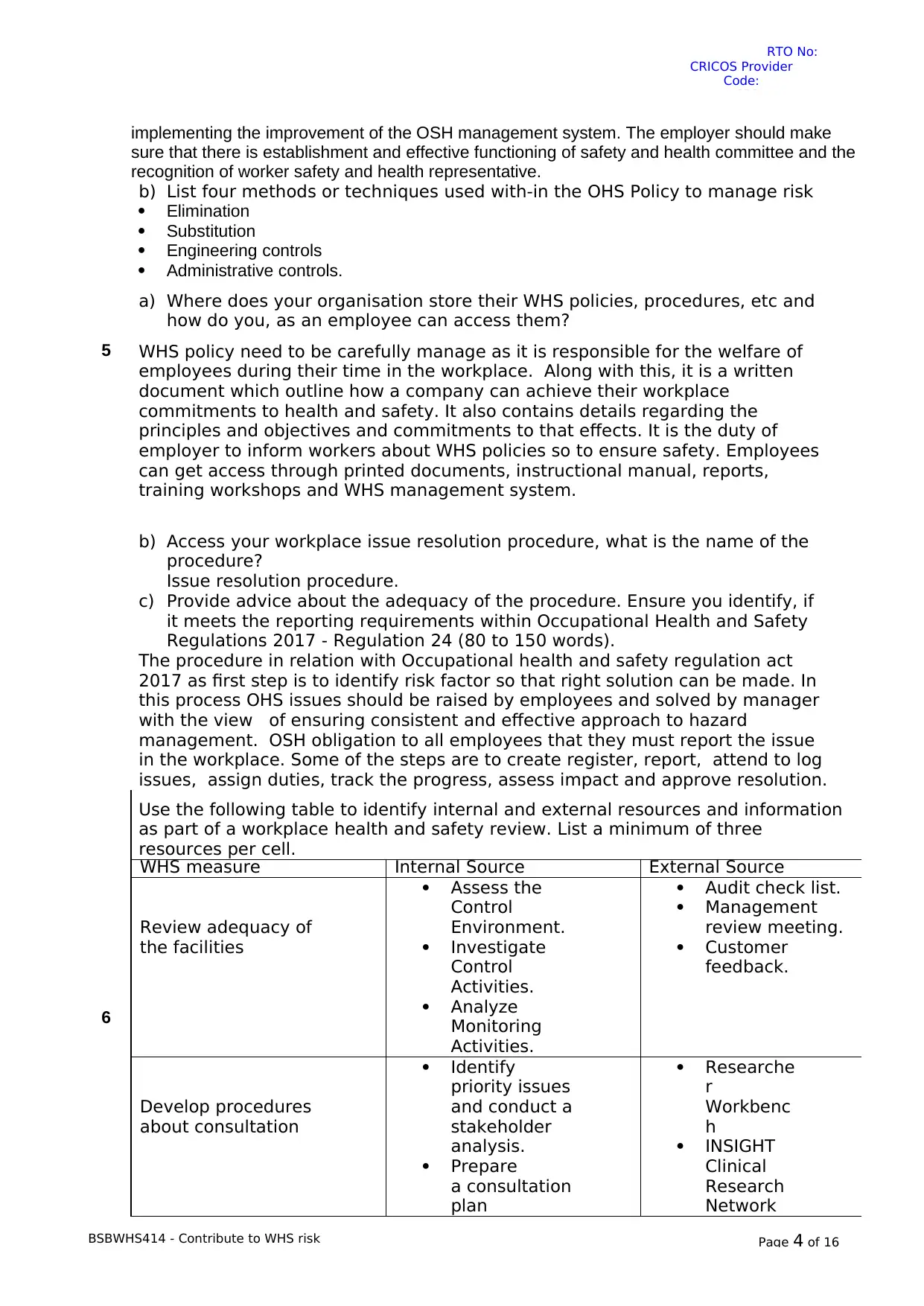
RTO No:
CRICOS Provider
Code:
ABN:
BSBWHS414 - Contribute to WHS risk
management Page 4 of 16
implementing the improvement of the OSH management system. The employer should make
sure that there is establishment and effective functioning of safety and health committee and the
recognition of worker safety and health representative.
b) List four methods or techniques used with-in the OHS Policy to manage risk
Elimination
Substitution
Engineering controls
Administrative controls.
5
a) Where does your organisation store their WHS policies, procedures, etc and
how do you, as an employee can access them?
WHS policy need to be carefully manage as it is responsible for the welfare of
employees during their time in the workplace. Along with this, it is a written
document which outline how a company can achieve their workplace
commitments to health and safety. It also contains details regarding the
principles and objectives and commitments to that effects. It is the duty of
employer to inform workers about WHS policies so to ensure safety. Employees
can get access through printed documents, instructional manual, reports,
training workshops and WHS management system.
b) Access your workplace issue resolution procedure, what is the name of the
procedure?
Issue resolution procedure.
c) Provide advice about the adequacy of the procedure. Ensure you identify, if
it meets the reporting requirements within Occupational Health and Safety
Regulations 2017 - Regulation 24 (80 to 150 words).
The procedure in relation with Occupational health and safety regulation act
2017 as first step is to identify risk factor so that right solution can be made. In
this process OHS issues should be raised by employees and solved by manager
with the view of ensuring consistent and effective approach to hazard
management. OSH obligation to all employees that they must report the issue
in the workplace. Some of the steps are to create register, report, attend to log
issues, assign duties, track the progress, assess impact and approve resolution.
6
Use the following table to identify internal and external resources and information
as part of a workplace health and safety review. List a minimum of three
resources per cell.
WHS measure Internal Source External Source
Review adequacy of
the facilities
Assess the
Control
Environment.
Investigate
Control
Activities.
Analyze
Monitoring
Activities.
Audit check list.
Management
review meeting.
Customer
feedback.
Develop procedures
about consultation
Identify
priority issues
and conduct a
stakeholder
analysis.
Prepare
a consultation
plan
Researche
r
Workbenc
h
INSIGHT
Clinical
Research
Network
CRICOS Provider
Code:
ABN:
BSBWHS414 - Contribute to WHS risk
management Page 4 of 16
implementing the improvement of the OSH management system. The employer should make
sure that there is establishment and effective functioning of safety and health committee and the
recognition of worker safety and health representative.
b) List four methods or techniques used with-in the OHS Policy to manage risk
Elimination
Substitution
Engineering controls
Administrative controls.
5
a) Where does your organisation store their WHS policies, procedures, etc and
how do you, as an employee can access them?
WHS policy need to be carefully manage as it is responsible for the welfare of
employees during their time in the workplace. Along with this, it is a written
document which outline how a company can achieve their workplace
commitments to health and safety. It also contains details regarding the
principles and objectives and commitments to that effects. It is the duty of
employer to inform workers about WHS policies so to ensure safety. Employees
can get access through printed documents, instructional manual, reports,
training workshops and WHS management system.
b) Access your workplace issue resolution procedure, what is the name of the
procedure?
Issue resolution procedure.
c) Provide advice about the adequacy of the procedure. Ensure you identify, if
it meets the reporting requirements within Occupational Health and Safety
Regulations 2017 - Regulation 24 (80 to 150 words).
The procedure in relation with Occupational health and safety regulation act
2017 as first step is to identify risk factor so that right solution can be made. In
this process OHS issues should be raised by employees and solved by manager
with the view of ensuring consistent and effective approach to hazard
management. OSH obligation to all employees that they must report the issue
in the workplace. Some of the steps are to create register, report, attend to log
issues, assign duties, track the progress, assess impact and approve resolution.
6
Use the following table to identify internal and external resources and information
as part of a workplace health and safety review. List a minimum of three
resources per cell.
WHS measure Internal Source External Source
Review adequacy of
the facilities
Assess the
Control
Environment.
Investigate
Control
Activities.
Analyze
Monitoring
Activities.
Audit check list.
Management
review meeting.
Customer
feedback.
Develop procedures
about consultation
Identify
priority issues
and conduct a
stakeholder
analysis.
Prepare
a consultation
plan
Researche
r
Workbenc
h
INSIGHT
Clinical
Research
Network
Paraphrase This Document
Need a fresh take? Get an instant paraphrase of this document with our AI Paraphraser
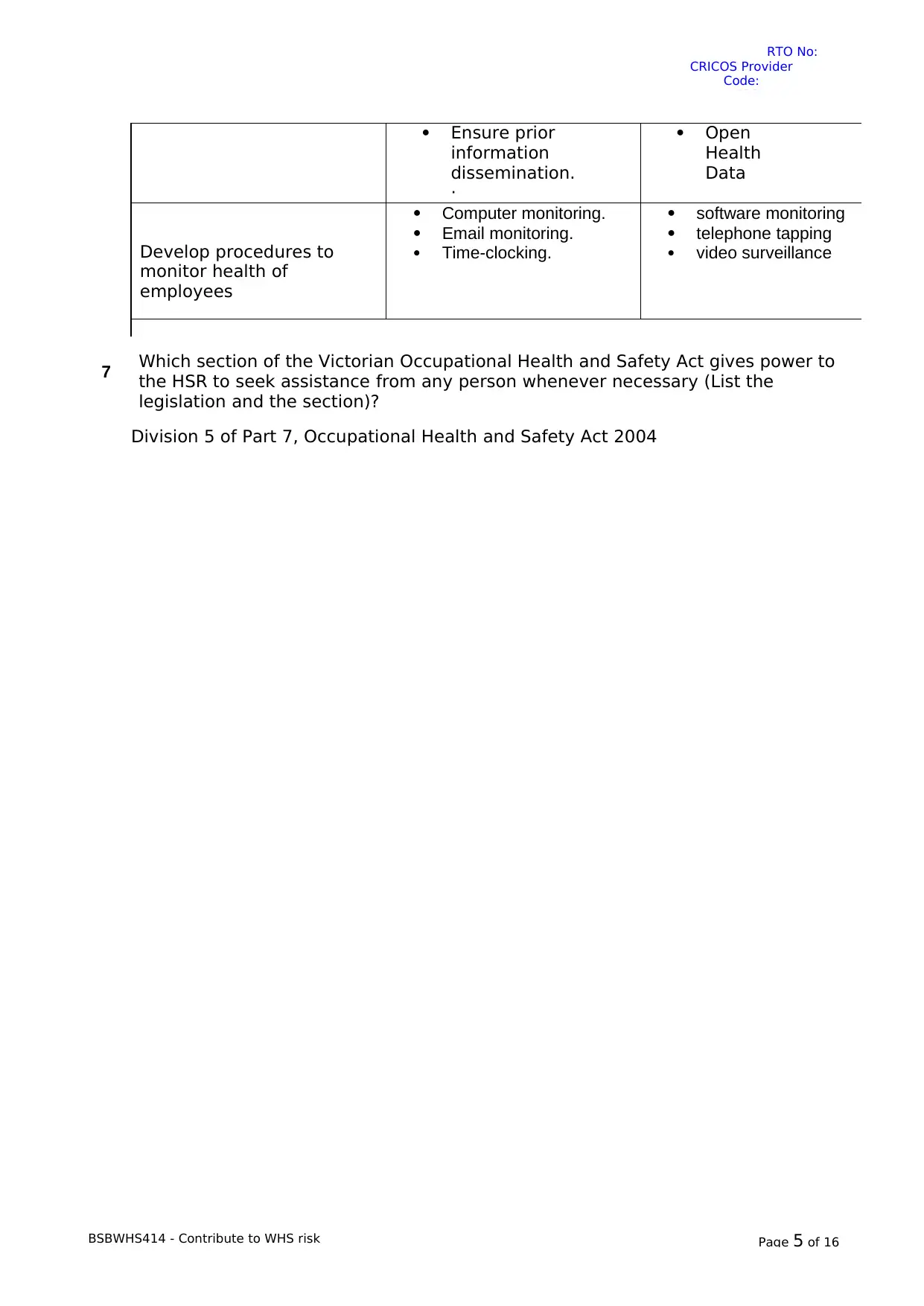
RTO No:
CRICOS Provider
Code:
ABN:
BSBWHS414 - Contribute to WHS risk
management Page 5 of 16
Ensure prior
information
dissemination.
·
Open
Health
Data
Develop procedures to
monitor health of
employees
Computer monitoring.
Email monitoring.
Time-clocking.
software monitoring
telephone tapping
video surveillance
7 Which section of the Victorian Occupational Health and Safety Act gives power to
the HSR to seek assistance from any person whenever necessary (List the
legislation and the section)?
Division 5 of Part 7, Occupational Health and Safety Act 2004
CRICOS Provider
Code:
ABN:
BSBWHS414 - Contribute to WHS risk
management Page 5 of 16
Ensure prior
information
dissemination.
·
Open
Health
Data
Develop procedures to
monitor health of
employees
Computer monitoring.
Email monitoring.
Time-clocking.
software monitoring
telephone tapping
video surveillance
7 Which section of the Victorian Occupational Health and Safety Act gives power to
the HSR to seek assistance from any person whenever necessary (List the
legislation and the section)?
Division 5 of Part 7, Occupational Health and Safety Act 2004
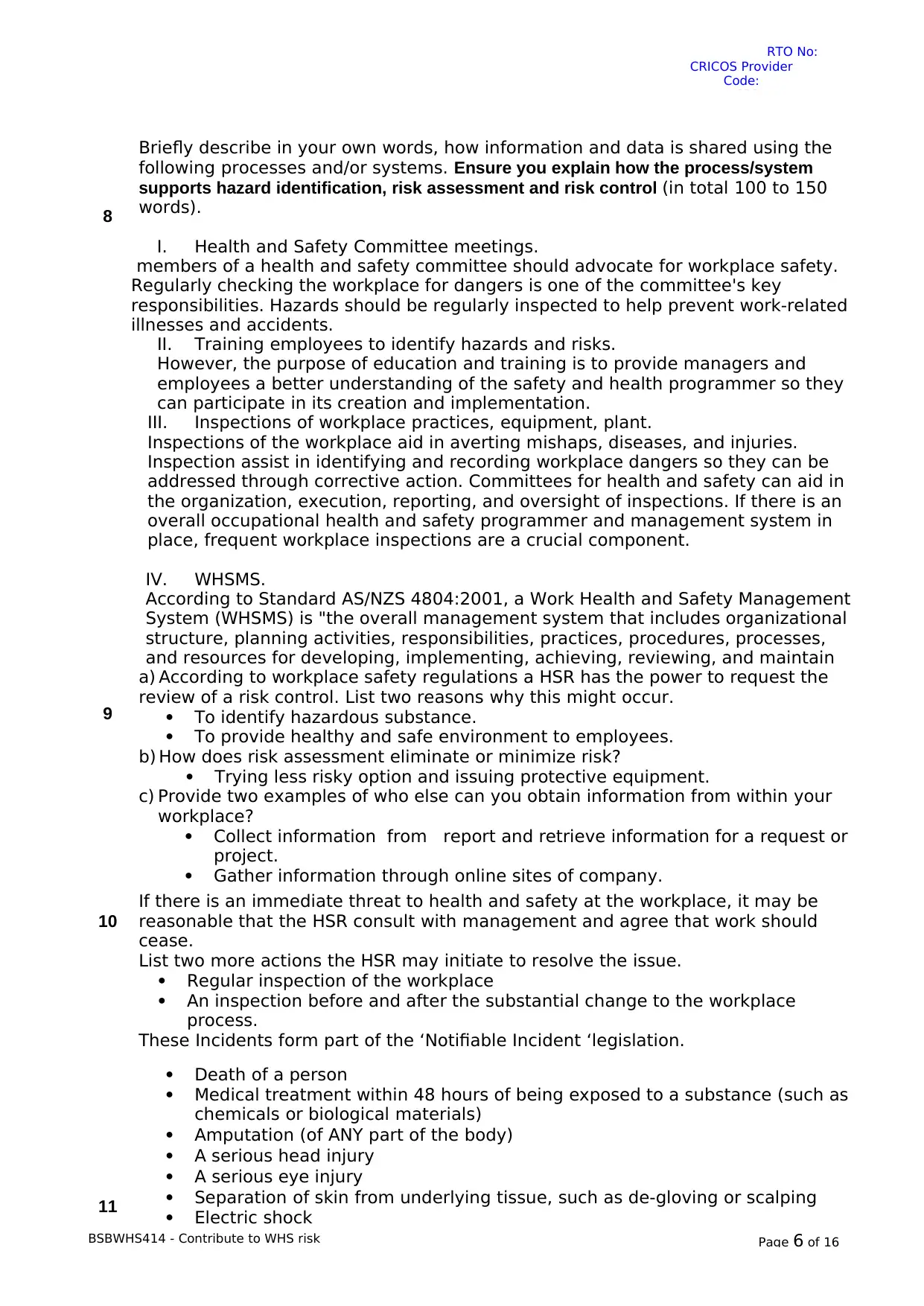
RTO No:
CRICOS Provider
Code:
ABN:
BSBWHS414 - Contribute to WHS risk
management Page 6 of 16
8
Briefly describe in your own words, how information and data is shared using the
following processes and/or systems. Ensure you explain how the process/system
supports hazard identification, risk assessment and risk control (in total 100 to 150
words).
I. Health and Safety Committee meetings.
members of a health and safety committee should advocate for workplace safety.
Regularly checking the workplace for dangers is one of the committee's key
responsibilities. Hazards should be regularly inspected to help prevent work-related
illnesses and accidents.
II. Training employees to identify hazards and risks.
However, the purpose of education and training is to provide managers and
employees a better understanding of the safety and health programmer so they
can participate in its creation and implementation.
III. Inspections of workplace practices, equipment, plant.
Inspections of the workplace aid in averting mishaps, diseases, and injuries.
Inspection assist in identifying and recording workplace dangers so they can be
addressed through corrective action. Committees for health and safety can aid in
the organization, execution, reporting, and oversight of inspections. If there is an
overall occupational health and safety programmer and management system in
place, frequent workplace inspections are a crucial component.
IV. WHSMS.
According to Standard AS/NZS 4804:2001, a Work Health and Safety Management
System (WHSMS) is "the overall management system that includes organizational
structure, planning activities, responsibilities, practices, procedures, processes,
and resources for developing, implementing, achieving, reviewing, and maintain
9
a) According to workplace safety regulations a HSR has the power to request the
review of a risk control. List two reasons why this might occur.
To identify hazardous substance.
To provide healthy and safe environment to employees.
b) How does risk assessment eliminate or minimize risk?
Trying less risky option and issuing protective equipment.
c) Provide two examples of who else can you obtain information from within your
workplace?
Collect information from report and retrieve information for a request or
project.
Gather information through online sites of company.
10
If there is an immediate threat to health and safety at the workplace, it may be
reasonable that the HSR consult with management and agree that work should
cease.
List two more actions the HSR may initiate to resolve the issue.
Regular inspection of the workplace
An inspection before and after the substantial change to the workplace
process.
11
These Incidents form part of the ‘Notifiable Incident ‘legislation.
Death of a person
Medical treatment within 48 hours of being exposed to a substance (such as
chemicals or biological materials)
Amputation (of ANY part of the body)
A serious head injury
A serious eye injury
Separation of skin from underlying tissue, such as de-gloving or scalping
Electric shock
CRICOS Provider
Code:
ABN:
BSBWHS414 - Contribute to WHS risk
management Page 6 of 16
8
Briefly describe in your own words, how information and data is shared using the
following processes and/or systems. Ensure you explain how the process/system
supports hazard identification, risk assessment and risk control (in total 100 to 150
words).
I. Health and Safety Committee meetings.
members of a health and safety committee should advocate for workplace safety.
Regularly checking the workplace for dangers is one of the committee's key
responsibilities. Hazards should be regularly inspected to help prevent work-related
illnesses and accidents.
II. Training employees to identify hazards and risks.
However, the purpose of education and training is to provide managers and
employees a better understanding of the safety and health programmer so they
can participate in its creation and implementation.
III. Inspections of workplace practices, equipment, plant.
Inspections of the workplace aid in averting mishaps, diseases, and injuries.
Inspection assist in identifying and recording workplace dangers so they can be
addressed through corrective action. Committees for health and safety can aid in
the organization, execution, reporting, and oversight of inspections. If there is an
overall occupational health and safety programmer and management system in
place, frequent workplace inspections are a crucial component.
IV. WHSMS.
According to Standard AS/NZS 4804:2001, a Work Health and Safety Management
System (WHSMS) is "the overall management system that includes organizational
structure, planning activities, responsibilities, practices, procedures, processes,
and resources for developing, implementing, achieving, reviewing, and maintain
9
a) According to workplace safety regulations a HSR has the power to request the
review of a risk control. List two reasons why this might occur.
To identify hazardous substance.
To provide healthy and safe environment to employees.
b) How does risk assessment eliminate or minimize risk?
Trying less risky option and issuing protective equipment.
c) Provide two examples of who else can you obtain information from within your
workplace?
Collect information from report and retrieve information for a request or
project.
Gather information through online sites of company.
10
If there is an immediate threat to health and safety at the workplace, it may be
reasonable that the HSR consult with management and agree that work should
cease.
List two more actions the HSR may initiate to resolve the issue.
Regular inspection of the workplace
An inspection before and after the substantial change to the workplace
process.
11
These Incidents form part of the ‘Notifiable Incident ‘legislation.
Death of a person
Medical treatment within 48 hours of being exposed to a substance (such as
chemicals or biological materials)
Amputation (of ANY part of the body)
A serious head injury
A serious eye injury
Separation of skin from underlying tissue, such as de-gloving or scalping
Electric shock
⊘ This is a preview!⊘
Do you want full access?
Subscribe today to unlock all pages.

Trusted by 1+ million students worldwide
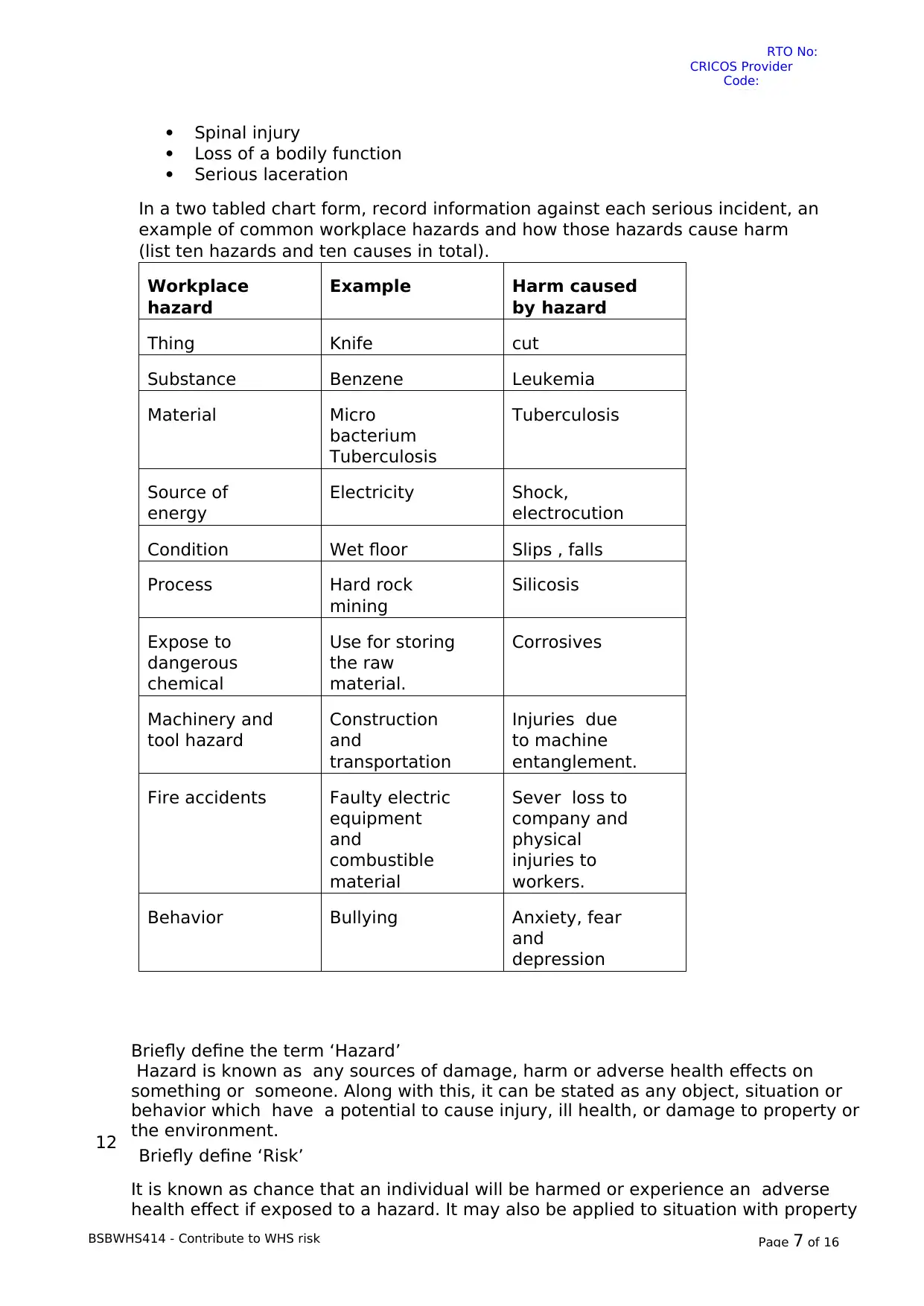
RTO No:
CRICOS Provider
Code:
ABN:
BSBWHS414 - Contribute to WHS risk
management Page 7 of 16
Spinal injury
Loss of a bodily function
Serious laceration
In a two tabled chart form, record information against each serious incident, an
example of common workplace hazards and how those hazards cause harm
(list ten hazards and ten causes in total).
Workplace
hazard
Example Harm caused
by hazard
Thing Knife cut
Substance Benzene Leukemia
Material Micro
bacterium
Tuberculosis
Tuberculosis
Source of
energy
Electricity Shock,
electrocution
Condition Wet floor Slips , falls
Process Hard rock
mining
Silicosis
Expose to
dangerous
chemical
Use for storing
the raw
material.
Corrosives
Machinery and
tool hazard
Construction
and
transportation
Injuries due
to machine
entanglement.
Fire accidents Faulty electric
equipment
and
combustible
material
Sever loss to
company and
physical
injuries to
workers.
Behavior Bullying Anxiety, fear
and
depression
12
Briefly define the term ‘Hazard’
Hazard is known as any sources of damage, harm or adverse health effects on
something or someone. Along with this, it can be stated as any object, situation or
behavior which have a potential to cause injury, ill health, or damage to property or
the environment.
Briefly define ‘Risk’
It is known as chance that an individual will be harmed or experience an adverse
health effect if exposed to a hazard. It may also be applied to situation with property
CRICOS Provider
Code:
ABN:
BSBWHS414 - Contribute to WHS risk
management Page 7 of 16
Spinal injury
Loss of a bodily function
Serious laceration
In a two tabled chart form, record information against each serious incident, an
example of common workplace hazards and how those hazards cause harm
(list ten hazards and ten causes in total).
Workplace
hazard
Example Harm caused
by hazard
Thing Knife cut
Substance Benzene Leukemia
Material Micro
bacterium
Tuberculosis
Tuberculosis
Source of
energy
Electricity Shock,
electrocution
Condition Wet floor Slips , falls
Process Hard rock
mining
Silicosis
Expose to
dangerous
chemical
Use for storing
the raw
material.
Corrosives
Machinery and
tool hazard
Construction
and
transportation
Injuries due
to machine
entanglement.
Fire accidents Faulty electric
equipment
and
combustible
material
Sever loss to
company and
physical
injuries to
workers.
Behavior Bullying Anxiety, fear
and
depression
12
Briefly define the term ‘Hazard’
Hazard is known as any sources of damage, harm or adverse health effects on
something or someone. Along with this, it can be stated as any object, situation or
behavior which have a potential to cause injury, ill health, or damage to property or
the environment.
Briefly define ‘Risk’
It is known as chance that an individual will be harmed or experience an adverse
health effect if exposed to a hazard. It may also be applied to situation with property
Paraphrase This Document
Need a fresh take? Get an instant paraphrase of this document with our AI Paraphraser
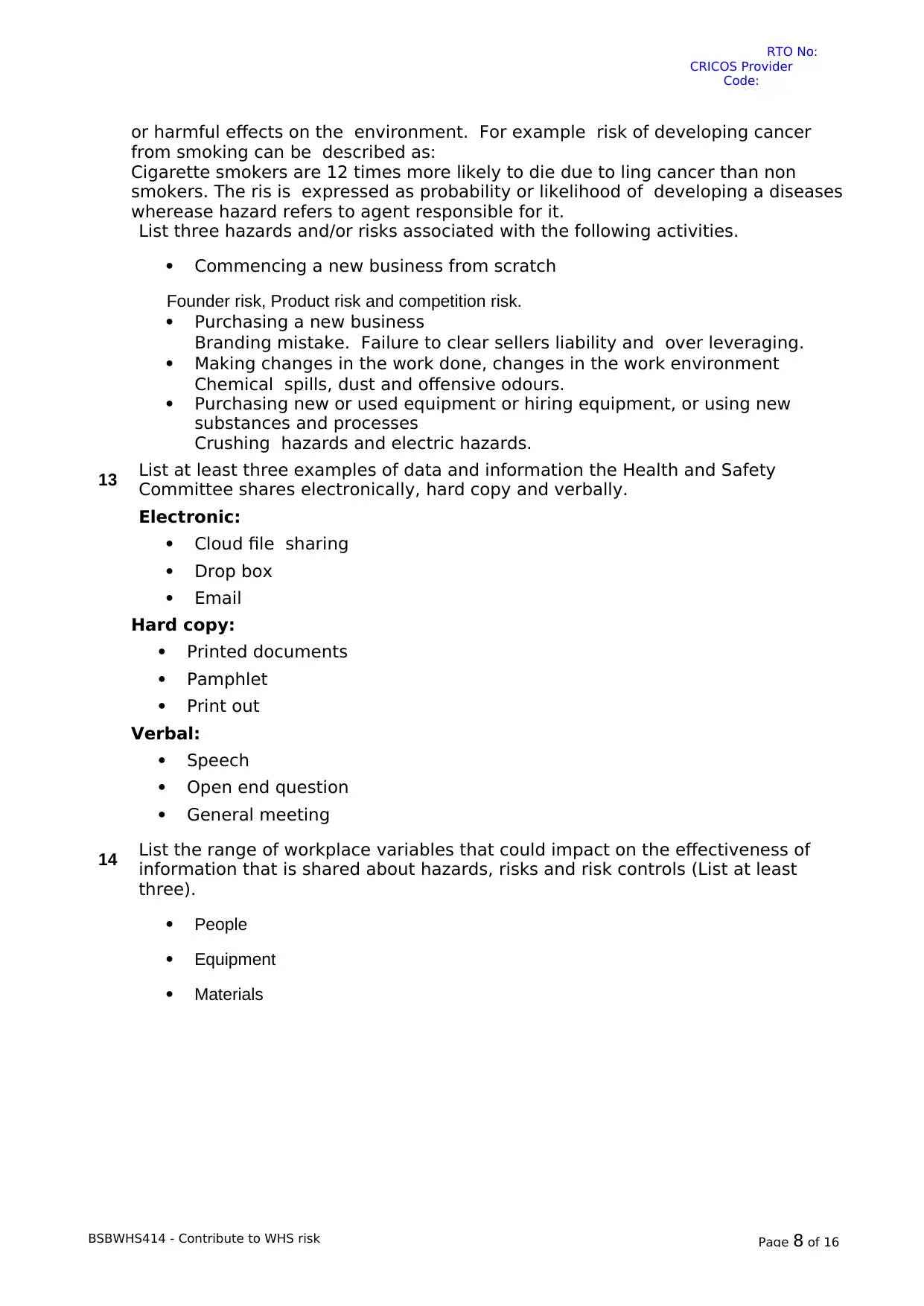
RTO No:
CRICOS Provider
Code:
ABN:
BSBWHS414 - Contribute to WHS risk
management Page 8 of 16
or harmful effects on the environment. For example risk of developing cancer
from smoking can be described as:
Cigarette smokers are 12 times more likely to die due to ling cancer than non
smokers. The ris is expressed as probability or likelihood of developing a diseases
wherease hazard refers to agent responsible for it.
List three hazards and/or risks associated with the following activities.
Commencing a new business from scratch
Founder risk, Product risk and competition risk.
Purchasing a new business
Branding mistake. Failure to clear sellers liability and over leveraging.
Making changes in the work done, changes in the work environment
Chemical spills, dust and offensive odours.
Purchasing new or used equipment or hiring equipment, or using new
substances and processes
Crushing hazards and electric hazards.
13 List at least three examples of data and information the Health and Safety
Committee shares electronically, hard copy and verbally.
Electronic:
Cloud file sharing
Drop box
Email
Hard copy:
Printed documents
Pamphlet
Print out
Verbal:
Speech
Open end question
General meeting
14 List the range of workplace variables that could impact on the effectiveness of
information that is shared about hazards, risks and risk controls (List at least
three).
People
Equipment
Materials
CRICOS Provider
Code:
ABN:
BSBWHS414 - Contribute to WHS risk
management Page 8 of 16
or harmful effects on the environment. For example risk of developing cancer
from smoking can be described as:
Cigarette smokers are 12 times more likely to die due to ling cancer than non
smokers. The ris is expressed as probability or likelihood of developing a diseases
wherease hazard refers to agent responsible for it.
List three hazards and/or risks associated with the following activities.
Commencing a new business from scratch
Founder risk, Product risk and competition risk.
Purchasing a new business
Branding mistake. Failure to clear sellers liability and over leveraging.
Making changes in the work done, changes in the work environment
Chemical spills, dust and offensive odours.
Purchasing new or used equipment or hiring equipment, or using new
substances and processes
Crushing hazards and electric hazards.
13 List at least three examples of data and information the Health and Safety
Committee shares electronically, hard copy and verbally.
Electronic:
Cloud file sharing
Drop box
Hard copy:
Printed documents
Pamphlet
Print out
Verbal:
Speech
Open end question
General meeting
14 List the range of workplace variables that could impact on the effectiveness of
information that is shared about hazards, risks and risk controls (List at least
three).
People
Equipment
Materials
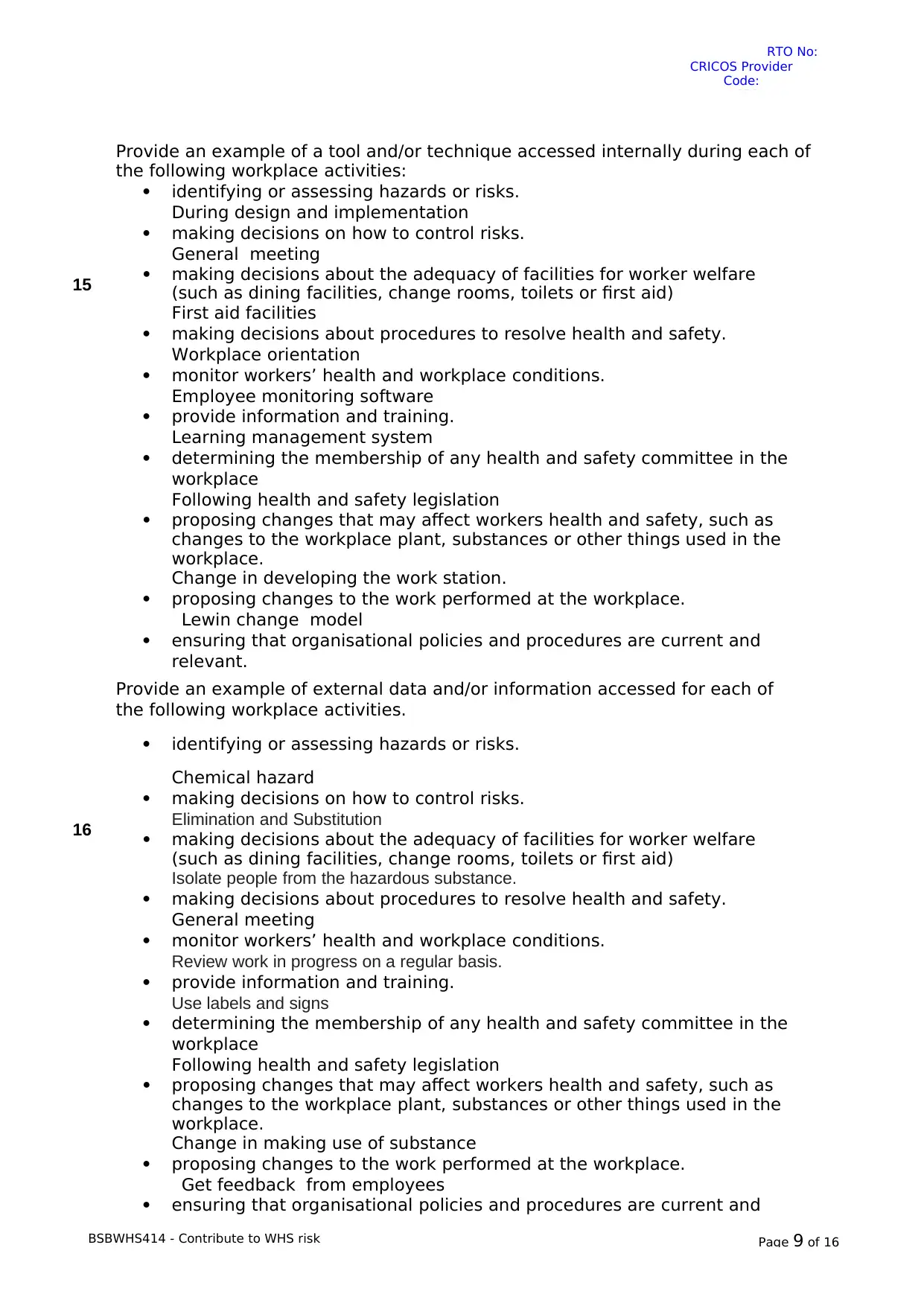
RTO No:
CRICOS Provider
Code:
ABN:
BSBWHS414 - Contribute to WHS risk
management Page 9 of 16
15
Provide an example of a tool and/or technique accessed internally during each of
the following workplace activities:
identifying or assessing hazards or risks.
During design and implementation
making decisions on how to control risks.
General meeting
making decisions about the adequacy of facilities for worker welfare
(such as dining facilities, change rooms, toilets or first aid)
First aid facilities
making decisions about procedures to resolve health and safety.
Workplace orientation
monitor workers’ health and workplace conditions.
Employee monitoring software
provide information and training.
Learning management system
determining the membership of any health and safety committee in the
workplace
Following health and safety legislation
proposing changes that may affect workers health and safety, such as
changes to the workplace plant, substances or other things used in the
workplace.
Change in developing the work station.
proposing changes to the work performed at the workplace.
Lewin change model
ensuring that organisational policies and procedures are current and
relevant.
16
Provide an example of external data and/or information accessed for each of
the following workplace activities.
identifying or assessing hazards or risks.
Chemical hazard
making decisions on how to control risks.
Elimination and Substitution
making decisions about the adequacy of facilities for worker welfare
(such as dining facilities, change rooms, toilets or first aid)
Isolate people from the hazardous substance.
making decisions about procedures to resolve health and safety.
General meeting
monitor workers’ health and workplace conditions.
Review work in progress on a regular basis.
provide information and training.
Use labels and signs
determining the membership of any health and safety committee in the
workplace
Following health and safety legislation
proposing changes that may affect workers health and safety, such as
changes to the workplace plant, substances or other things used in the
workplace.
Change in making use of substance
proposing changes to the work performed at the workplace.
Get feedback from employees
ensuring that organisational policies and procedures are current and
CRICOS Provider
Code:
ABN:
BSBWHS414 - Contribute to WHS risk
management Page 9 of 16
15
Provide an example of a tool and/or technique accessed internally during each of
the following workplace activities:
identifying or assessing hazards or risks.
During design and implementation
making decisions on how to control risks.
General meeting
making decisions about the adequacy of facilities for worker welfare
(such as dining facilities, change rooms, toilets or first aid)
First aid facilities
making decisions about procedures to resolve health and safety.
Workplace orientation
monitor workers’ health and workplace conditions.
Employee monitoring software
provide information and training.
Learning management system
determining the membership of any health and safety committee in the
workplace
Following health and safety legislation
proposing changes that may affect workers health and safety, such as
changes to the workplace plant, substances or other things used in the
workplace.
Change in developing the work station.
proposing changes to the work performed at the workplace.
Lewin change model
ensuring that organisational policies and procedures are current and
relevant.
16
Provide an example of external data and/or information accessed for each of
the following workplace activities.
identifying or assessing hazards or risks.
Chemical hazard
making decisions on how to control risks.
Elimination and Substitution
making decisions about the adequacy of facilities for worker welfare
(such as dining facilities, change rooms, toilets or first aid)
Isolate people from the hazardous substance.
making decisions about procedures to resolve health and safety.
General meeting
monitor workers’ health and workplace conditions.
Review work in progress on a regular basis.
provide information and training.
Use labels and signs
determining the membership of any health and safety committee in the
workplace
Following health and safety legislation
proposing changes that may affect workers health and safety, such as
changes to the workplace plant, substances or other things used in the
workplace.
Change in making use of substance
proposing changes to the work performed at the workplace.
Get feedback from employees
ensuring that organisational policies and procedures are current and
⊘ This is a preview!⊘
Do you want full access?
Subscribe today to unlock all pages.

Trusted by 1+ million students worldwide
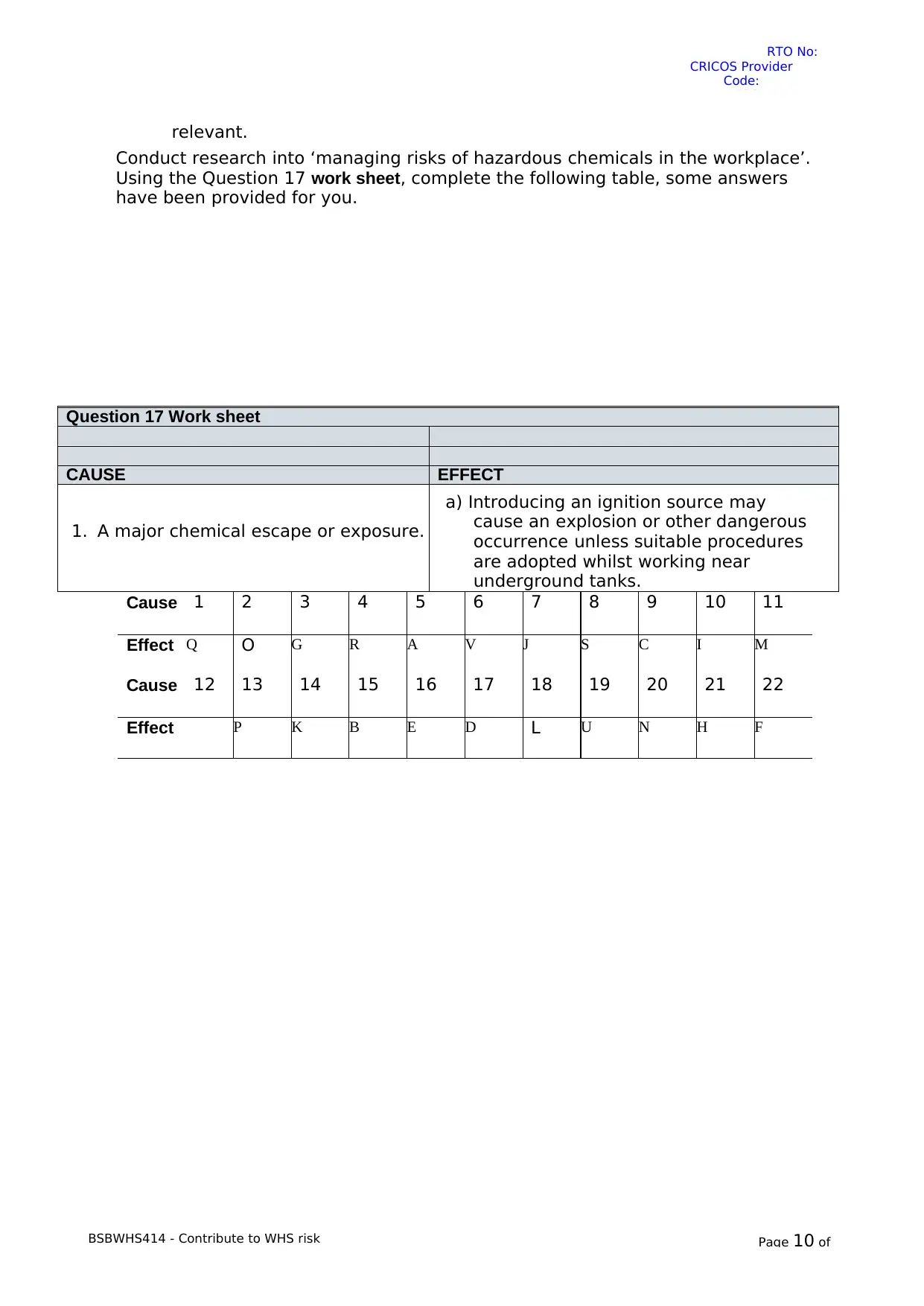
RTO No:
CRICOS Provider
Code:
ABN:
BSBWHS414 - Contribute to WHS risk
management Page 10 of
relevant.
Conduct research into ‘managing risks of hazardous chemicals in the workplace’.
Using the Question 17 work sheet, complete the following table, some answers
have been provided for you.
Question 17 Work sheet
CAUSE EFFECT
1. A major chemical escape or exposure.
a) Introducing an ignition source may
cause an explosion or other dangerous
occurrence unless suitable procedures
are adopted whilst working near
underground tanks.
Cause 1 2 3 4 5 6 7 8 9 10 11
Effect Q O G R A V J S C I M
Cause 12 13 14 15 16 17 18 19 20 21 22
Effect P K B E D L U N H F
CRICOS Provider
Code:
ABN:
BSBWHS414 - Contribute to WHS risk
management Page 10 of
relevant.
Conduct research into ‘managing risks of hazardous chemicals in the workplace’.
Using the Question 17 work sheet, complete the following table, some answers
have been provided for you.
Question 17 Work sheet
CAUSE EFFECT
1. A major chemical escape or exposure.
a) Introducing an ignition source may
cause an explosion or other dangerous
occurrence unless suitable procedures
are adopted whilst working near
underground tanks.
Cause 1 2 3 4 5 6 7 8 9 10 11
Effect Q O G R A V J S C I M
Cause 12 13 14 15 16 17 18 19 20 21 22
Effect P K B E D L U N H F
Paraphrase This Document
Need a fresh take? Get an instant paraphrase of this document with our AI Paraphraser
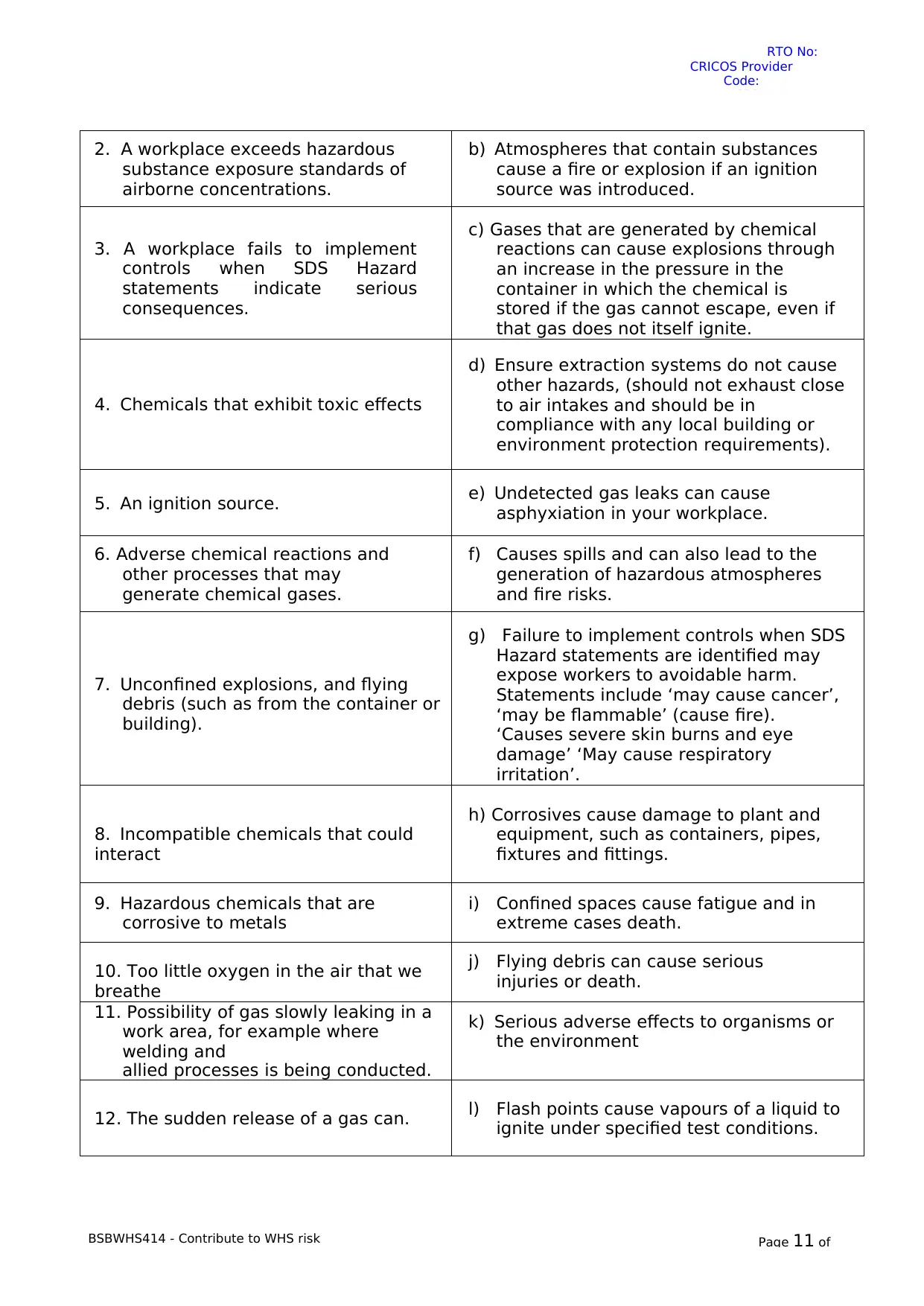
RTO No:
CRICOS Provider
Code:
ABN:
BSBWHS414 - Contribute to WHS risk
management Page 11 of
2. A workplace exceeds hazardous
substance exposure standards of
airborne concentrations.
b) Atmospheres that contain substances
cause a fire or explosion if an ignition
source was introduced.
3. A workplace fails to implement
controls when SDS Hazard
statements indicate serious
consequences.
c) Gases that are generated by chemical
reactions can cause explosions through
an increase in the pressure in the
container in which the chemical is
stored if the gas cannot escape, even if
that gas does not itself ignite.
4. Chemicals that exhibit toxic effects
d) Ensure extraction systems do not cause
other hazards, (should not exhaust close
to air intakes and should be in
compliance with any local building or
environment protection requirements).
5. An ignition source. e) Undetected gas leaks can cause
asphyxiation in your workplace.
6. Adverse chemical reactions and
other processes that may
generate chemical gases.
f) Causes spills and can also lead to the
generation of hazardous atmospheres
and fire risks.
7. Unconfined explosions, and flying
debris (such as from the container or
building).
g) Failure to implement controls when SDS
Hazard statements are identified may
expose workers to avoidable harm.
Statements include ‘may cause cancer’,
‘may be flammable’ (cause fire).
‘Causes severe skin burns and eye
damage’ ‘May cause respiratory
irritation’.
8. Incompatible chemicals that could
interact
h) Corrosives cause damage to plant and
equipment, such as containers, pipes,
fixtures and fittings.
9. Hazardous chemicals that are
corrosive to metals
i) Confined spaces cause fatigue and in
extreme cases death.
10. Too little oxygen in the air that we
breathe
j) Flying debris can cause serious
injuries or death.
11. Possibility of gas slowly leaking in a
work area, for example where
welding and
allied processes is being conducted.
k) Serious adverse effects to organisms or
the environment
12. The sudden release of a gas can. l) Flash points cause vapours of a liquid to
ignite under specified test conditions.
CRICOS Provider
Code:
ABN:
BSBWHS414 - Contribute to WHS risk
management Page 11 of
2. A workplace exceeds hazardous
substance exposure standards of
airborne concentrations.
b) Atmospheres that contain substances
cause a fire or explosion if an ignition
source was introduced.
3. A workplace fails to implement
controls when SDS Hazard
statements indicate serious
consequences.
c) Gases that are generated by chemical
reactions can cause explosions through
an increase in the pressure in the
container in which the chemical is
stored if the gas cannot escape, even if
that gas does not itself ignite.
4. Chemicals that exhibit toxic effects
d) Ensure extraction systems do not cause
other hazards, (should not exhaust close
to air intakes and should be in
compliance with any local building or
environment protection requirements).
5. An ignition source. e) Undetected gas leaks can cause
asphyxiation in your workplace.
6. Adverse chemical reactions and
other processes that may
generate chemical gases.
f) Causes spills and can also lead to the
generation of hazardous atmospheres
and fire risks.
7. Unconfined explosions, and flying
debris (such as from the container or
building).
g) Failure to implement controls when SDS
Hazard statements are identified may
expose workers to avoidable harm.
Statements include ‘may cause cancer’,
‘may be flammable’ (cause fire).
‘Causes severe skin burns and eye
damage’ ‘May cause respiratory
irritation’.
8. Incompatible chemicals that could
interact
h) Corrosives cause damage to plant and
equipment, such as containers, pipes,
fixtures and fittings.
9. Hazardous chemicals that are
corrosive to metals
i) Confined spaces cause fatigue and in
extreme cases death.
10. Too little oxygen in the air that we
breathe
j) Flying debris can cause serious
injuries or death.
11. Possibility of gas slowly leaking in a
work area, for example where
welding and
allied processes is being conducted.
k) Serious adverse effects to organisms or
the environment
12. The sudden release of a gas can. l) Flash points cause vapours of a liquid to
ignite under specified test conditions.
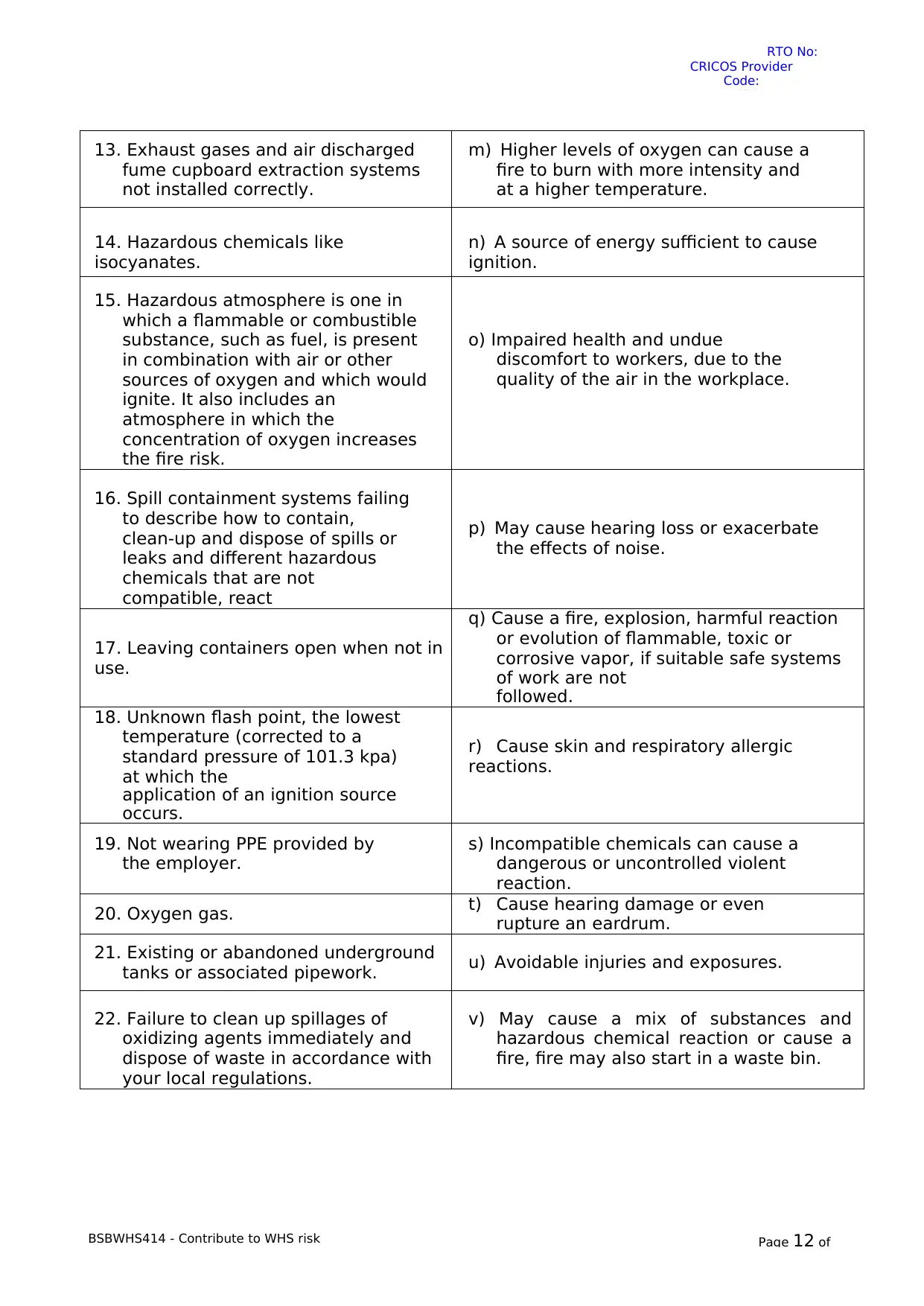
RTO No:
CRICOS Provider
Code:
ABN:
BSBWHS414 - Contribute to WHS risk
management Page 12 of
13. Exhaust gases and air discharged
fume cupboard extraction systems
not installed correctly.
m) Higher levels of oxygen can cause a
fire to burn with more intensity and
at a higher temperature.
14. Hazardous chemicals like
isocyanates.
n) A source of energy sufficient to cause
ignition.
15. Hazardous atmosphere is one in
which a flammable or combustible
substance, such as fuel, is present
in combination with air or other
sources of oxygen and which would
ignite. It also includes an
atmosphere in which the
concentration of oxygen increases
the fire risk.
o) Impaired health and undue
discomfort to workers, due to the
quality of the air in the workplace.
16. Spill containment systems failing
to describe how to contain,
clean-up and dispose of spills or
leaks and different hazardous
chemicals that are not
compatible, react
p) May cause hearing loss or exacerbate
the effects of noise.
17. Leaving containers open when not in
use.
q) Cause a fire, explosion, harmful reaction
or evolution of flammable, toxic or
corrosive vapor, if suitable safe systems
of work are not
followed.
18. Unknown flash point, the lowest
temperature (corrected to a
standard pressure of 101.3 kpa)
at which the
application of an ignition source
occurs.
r) Cause skin and respiratory allergic
reactions.
19. Not wearing PPE provided by
the employer.
s) Incompatible chemicals can cause a
dangerous or uncontrolled violent
reaction.
20. Oxygen gas. t) Cause hearing damage or even
rupture an eardrum.
21. Existing or abandoned underground
tanks or associated pipework. u) Avoidable injuries and exposures.
22. Failure to clean up spillages of
oxidizing agents immediately and
dispose of waste in accordance with
your local regulations.
v) May cause a mix of substances and
hazardous chemical reaction or cause a
fire, fire may also start in a waste bin.
CRICOS Provider
Code:
ABN:
BSBWHS414 - Contribute to WHS risk
management Page 12 of
13. Exhaust gases and air discharged
fume cupboard extraction systems
not installed correctly.
m) Higher levels of oxygen can cause a
fire to burn with more intensity and
at a higher temperature.
14. Hazardous chemicals like
isocyanates.
n) A source of energy sufficient to cause
ignition.
15. Hazardous atmosphere is one in
which a flammable or combustible
substance, such as fuel, is present
in combination with air or other
sources of oxygen and which would
ignite. It also includes an
atmosphere in which the
concentration of oxygen increases
the fire risk.
o) Impaired health and undue
discomfort to workers, due to the
quality of the air in the workplace.
16. Spill containment systems failing
to describe how to contain,
clean-up and dispose of spills or
leaks and different hazardous
chemicals that are not
compatible, react
p) May cause hearing loss or exacerbate
the effects of noise.
17. Leaving containers open when not in
use.
q) Cause a fire, explosion, harmful reaction
or evolution of flammable, toxic or
corrosive vapor, if suitable safe systems
of work are not
followed.
18. Unknown flash point, the lowest
temperature (corrected to a
standard pressure of 101.3 kpa)
at which the
application of an ignition source
occurs.
r) Cause skin and respiratory allergic
reactions.
19. Not wearing PPE provided by
the employer.
s) Incompatible chemicals can cause a
dangerous or uncontrolled violent
reaction.
20. Oxygen gas. t) Cause hearing damage or even
rupture an eardrum.
21. Existing or abandoned underground
tanks or associated pipework. u) Avoidable injuries and exposures.
22. Failure to clean up spillages of
oxidizing agents immediately and
dispose of waste in accordance with
your local regulations.
v) May cause a mix of substances and
hazardous chemical reaction or cause a
fire, fire may also start in a waste bin.
⊘ This is a preview!⊘
Do you want full access?
Subscribe today to unlock all pages.

Trusted by 1+ million students worldwide
1 out of 26
Related Documents
Your All-in-One AI-Powered Toolkit for Academic Success.
+13062052269
info@desklib.com
Available 24*7 on WhatsApp / Email
![[object Object]](/_next/static/media/star-bottom.7253800d.svg)
Unlock your academic potential
Copyright © 2020–2025 A2Z Services. All Rights Reserved. Developed and managed by ZUCOL.





